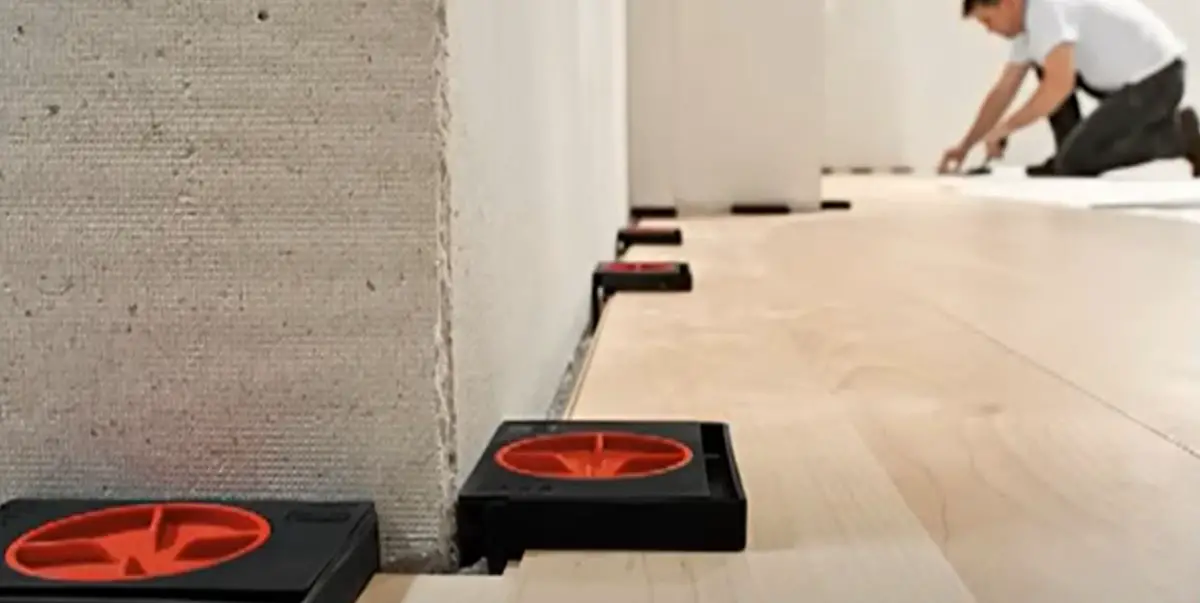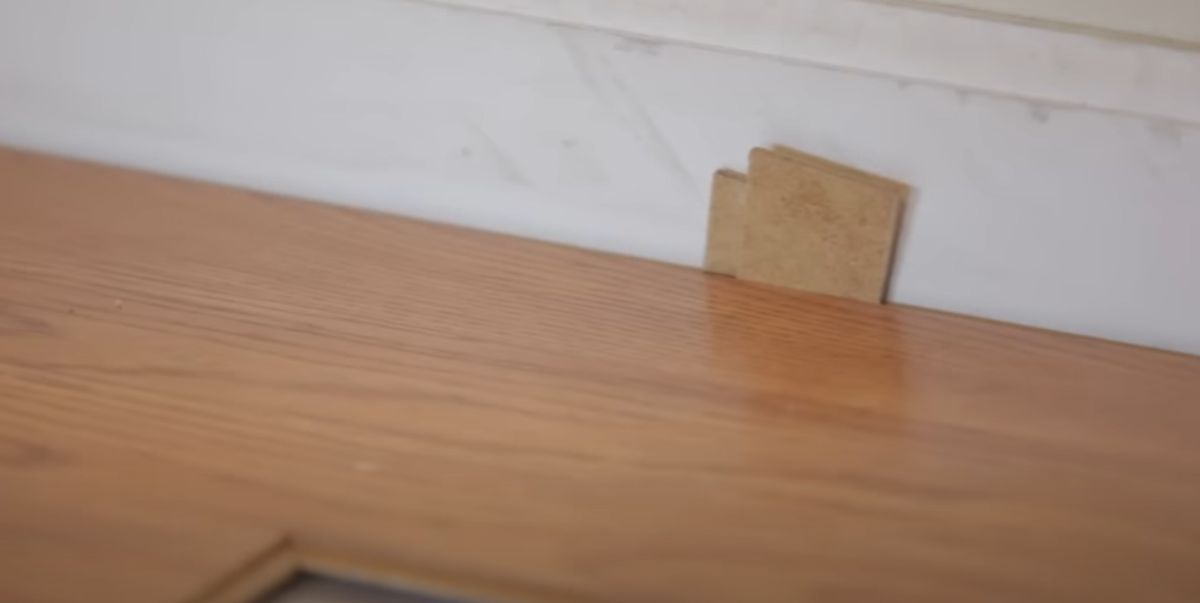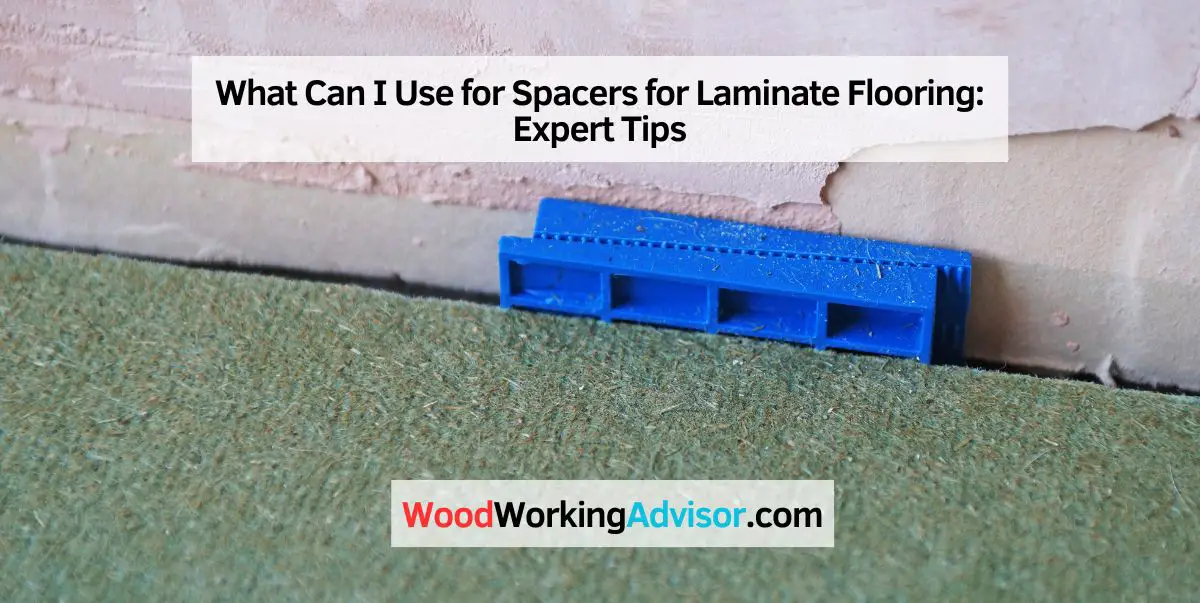You can use plastic spacers or wooden dowels as spacers for laminate flooring. Plastic spacers or wooden dowels can be used as effective spacers for laminate flooring.
These spacers provide the necessary gap between the flooring and the walls to allow for expansion and contraction. They ensure that the laminate flooring has enough room to move without buckling or warping. Plastic spacers are readily available at home improvement stores and are easy to install.
They are durable, moisture-resistant, and provide a stable base for the flooring. On the other hand, wooden dowels are a cost-effective alternative and can be cut to the desired length. They are also easy to replace if needed. Properly placed spacers are essential for the success and longevity of your laminate flooring installation.
Different Types Of Spacers
When it comes to installing laminate flooring, using spacers is essential for achieving a professional and visually appealing result. Spacers help create the necessary gap between the flooring and the walls or other fixed objects, allowing room for expansion and contraction of the laminate. There are several types of spacers available, including plastic spacers, wooden spacers, and specialized flooring spacers.
Plastic Spacers
Plastic spacers are commonly used in laminate flooring installations due to their affordability and ease of use. These spacers are typically made from high-quality plastic materials that are durable and resistant to moisture. Plastic spacers come in various shapes and sizes, allowing you to customize the gaps according to your preferences and the specific requirements of your laminate flooring.
One advantage of plastic spacers is that they can be easily snapped together, providing a secure and stable structure for your laminate flooring. Additionally, plastic spacers are lightweight, making them convenient to handle and transport during the installation process. Another benefit is that plastic spacers are reusable, ensuring that you can repurpose them for future flooring projects.
Wooden Spacers
Wooden spacers offer a more natural and aesthetic option for your laminate flooring installation. These spacers are typically made from wood materials such as birch or pine, providing a sturdy and reliable support for your flooring. Wooden spacers are available in various sizes and shapes, allowing you to create precise and consistent gaps.
One advantage of wooden spacers is their ability to absorb moisture, minimizing the risk of swelling or warping in case of any water-related incidents. Furthermore, wooden spacers can easily be cut or adjusted to fit any irregular or tight spaces in your flooring installation. However, it’s important to ensure that the wood used for the spacers is properly sealed or treated to protect against moisture absorption.
Specialized Flooring Spacers
In addition to plastic and wooden spacers, there are specialized flooring spacers specifically designed for laminate flooring installations. These spacers often have adjustable mechanisms or features that allow for precise gap adjustments. They are typically made from durable materials such as metal or hard plastic, ensuring a long-lasting and reliable performance.
Specialized flooring spacers come in different shapes and sizes, catering to various installation needs. Some spacers even include leveling systems, ensuring that your laminate flooring is installed perfectly leveled. However, these specialized spacers are generally more expensive compared to plastic or wooden ones.
Table: Comparison of Different Types of Spacers
| Spacer Type | Advantages | Disadvantages |
|---|---|---|
| Plastic Spacers | Affordable, easy to use, customizable | Not as aesthetically pleasing |
| Wooden Spacers | Natural and aesthetic, moisture-absorbent | Requires proper sealing, may require cutting or adjusting |
| Specialized Spacers | Precise gap adjustments, leveling systems | More expensive |
Alternative Spacer Options
When installing laminate flooring, one of the key steps is to ensure proper spacing between the planks. This allows for expansion and contraction of the flooring material and helps achieve a professional-looking finish. While plastic spacers are commonly used for this purpose, there are alternative options that you can consider. In this article, we’ll explore a few creative and readily available alternatives to plastic spacers for laminate flooring.
Cardboard Shims
Cardboard shims are a popular alternative to plastic spacers when it comes to laminate flooring installation. These thin strips of cardboard can be easily cut and used to create the necessary gap between the planks. The advantage of using cardboard shims is that they are inexpensive and readily available. Plus, they can be easily adjusted to achieve the desired spacing. To create your own cardboard shims, simply cut pieces of cardboard to the desired width and length, and slide them into the gaps between the planks.
Pennies And Coins As Spacers
Another creative option for spacers is to use pennies or coins. These small, flat objects can be placed between the planks to achieve the desired gap. The advantage of using coins is that they are readily available and come in different sizes, allowing you to adjust the spacing as needed. Simply place the coins vertically between the planks and ensure they are evenly spaced. This method is particularly useful if you don’t have cardboard shims or plastic spacers on hand.
Diy Spacer Techniques
Aside from cardboard shims and coins, there are a few other DIY spacer techniques you can try. One option is to use wooden dowels or popsicle sticks as spacers. These can be easily cut to the desired length and placed between the planks. Another technique involves using foam weatherstripping. Cut the weatherstripping into thin strips and insert them into the gaps to create a consistent space between the planks. Additionally, you can also use small wooden blocks or scraps of hardwood flooring as spacers. These can be cut to size and placed between the planks to achieve the desired gap.

Factors To Consider When Choosing Spacers
When it comes to installing laminate flooring, choosing the right spacers is crucial for achieving a professional finish. There are several factors to consider when selecting spacers for laminate flooring, including the material and durability, ease of installation, and impact on flooring alignment.
Material And Durability
When choosing spacers for laminate flooring, it’s important to prioritize durable materials such as plastic or rubber. These materials provide the necessary strength to maintain consistent spacing between the laminate planks, ultimately ensuring a stable and long-lasting flooring installation.
Ease Of Installation
When selecting spacers, prioritize ones that are easy to handle and place between the planks. Look for spacers with convenient features such as snap-off tabs or a user-friendly design, making the installation process seamless and efficient.
Impact On Flooring Alignment
Choosing the right spacers for laminate flooring can significantly impact the alignment and overall appearance of the floor. Opt for spacers that promote precise positioning and alignment of the laminate planks, ensuring a clean and professional finish.

Expert Tips For Using Spacers
When installing laminate flooring, using spacers is a crucial step that ensures a professional and long-lasting result. These small devices help maintain proper expansion gaps and ensure the floor aligns perfectly. In this section, we will discuss expert tips for using spacers, including maintenance, removal, and alignment techniques that will help you achieve a flawless laminate floor installation.
Maintaining Consistent Expansion Gaps
One of the most important aspects of using spacers is to maintain consistent expansion gaps. These gaps allow your laminate flooring to expand and contract naturally with fluctuations in temperature and humidity, preventing warping or buckling. To achieve this:
- Place one spacer against each wall, ensuring an even gap between the laminate planks and the wall.
- Place spacers at regular intervals along the walls, ensuring consistent gaps between the planks.
Remember: Consistency is key! Pay attention to the positioning and alignment of the spacers to ensure even gaps throughout the entire floor.
Removing Spacers At The Right Time
Once you have installed the laminate flooring, it’s essential to remove the spacers at the right time to achieve a professional finish. Removing the spacers too soon can cause the floor planks to shift and ruin the alignment. Follow these steps for removing spacers:
- Carefully remove the baseboards or quarter-round molding along the walls.
- Gently lift each laminate plank, starting from the wall opposite the installation direction.
- As you lift each plank, remove the spacers and replace the plank snugly against the wall.
- Continue this process until all spacers are removed and the floor is tightly aligned.
Note: Removing spacers at the right time and properly aligning the planks will ensure a seamless and professional looking laminate floor.
Ensuring Proper Floor Alignment
Using spacers is crucial for achieving proper floor alignment, which gives your laminate flooring a polished and visually appealing look. Here are a few tips to ensure proper alignment:
- Regularly check and adjust the alignment of the spacers as you progress with the installation.
- Use a tapping block and rubber mallet to align each plank tightly against the spacers.
- Continue checking alignment throughout the installation process, making adjustments as needed.
Tip: Proper alignment not only enhances the aesthetics of your laminate floor, but it also improves its durability and longevity.
Common Mistakes To Avoid With Spacers
When installing laminate flooring, using spacers is crucial to ensure a proper fit and allow for necessary expansion. However, there are common mistakes that people often make when it comes to using spacers. These mistakes can have a significant impact on the overall quality and longevity of your laminate flooring.
Using Improperly Sized Spacers
One of the most common mistakes is using improperly sized spacers. It’s important to remember that the size of the spacers should correspond to the recommended expansion gap for your specific laminate flooring. Failure to use the right size spacers can result in gaps that are either too narrow or too wide, affecting the appearance and stability of your flooring.
To avoid this mistake, make sure to carefully read and follow the manufacturer’s instructions regarding the recommended spacer size. The recommended gap size will typically depend on the specific type and brand of laminate flooring you are installing. Taking the time to measure and select the appropriate spacers will go a long way in ensuring a successful and visually pleasing installation.
Overlooking Expansion Gap Requirements
Another common mistake when using spacers is overlooking the required expansion gap. Laminate flooring needs room to expand and contract with changes in temperature and humidity. Failure to leave an adequate expansion gap can lead to buckling, warping, and other issues over time.
It’s crucial to refer to the manufacturer’s guidelines to determine the correct expansion gap for your specific laminate flooring. Typically, a gap of around 1/4 to 1/2 inch is recommended. Remember to take into account any additional requirements or recommendations based on the type of subfloor or installation method you are using.
Ignoring the expansion gap requirements can result in costly repairs or even having to replace the entire floor down the line. By properly considering and accommodating the necessary expansion gap, you can avoid potential issues and ensure a long-lasting laminate flooring installation.
Neglecting Spacer Removal
Once the laminate flooring installation is complete, it’s important to remove the spacers before finishing touches are applied. Neglecting to remove the spacers can lead to an uneven finish and potential damage to the floor’s edges.
After removing the spacers, thoroughly inspect the installation area for any remaining debris or gaps. This will allow you to make any necessary adjustments or repairs before proceeding with the final stages of the installation, such as installing baseboards or transition pieces.
Using spacers correctly is crucial for a successful laminate flooring installation. Avoid the common mistakes of using improperly sized spacers, overlooking expansion gap requirements, and neglecting spacer removal to ensure a visually appealing, durable, and long-lasting laminate flooring in your space.

Frequently Asked Questions Of What Can I Use For Spacers For Laminate Flooring
What Can I Use For Laminate Spacers?
You can use plastic spacers or wooden shims for laminate installation. These spacers help maintain an even gap between the flooring and the walls. Using the right spacers ensures a professional-looking finish and prevents potential problems with the flooring.
What Happens If You Don T Use Spacers When Installing Laminate Flooring?
Not using spacers when installing laminate flooring can result in various issues. Without spacers, the flooring may not have proper expansion room, leading to buckling, warping, or gaps between the planks. Spacers help maintain consistent spacing, ensuring the installation is durable and visually appealing.
What Size Spacers Are Needed For Laminate Flooring?
For laminate flooring, spacers that are 1/4 inch in size are generally recommended. These spacers help create the necessary expansion gap between the flooring and the walls, allowing for movement and preventing buckling or warping over time.
Do You Really Need Expansion Gap Laminate Flooring?
Yes, you do need an expansion gap for laminate flooring to accommodate for temperature changes.
Conclusion
Spacers for laminate flooring play a crucial role in maintaining the integrity and longevity of your flooring installation. It is important to use the right spacers to ensure proper expansion and contraction of the laminate boards. By following the recommendations you can confidently select and utilize the most suitable spacers for your laminate flooring project.

